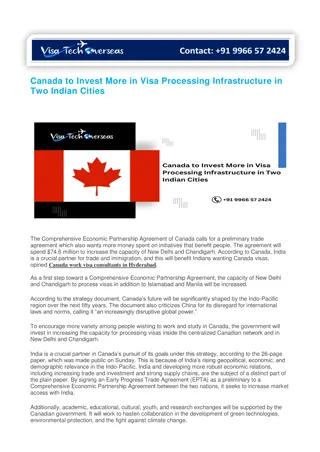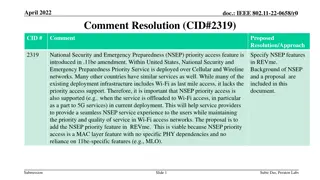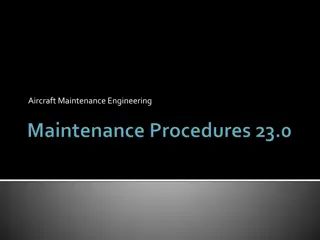Understanding Wait Time Methodology for Priority Procedures in Canada
This document outlines the methodology, definitions, and history of wait times for priority procedures as established by the Canadian Institute for Health Information (CIHI). It includes information on wait time segments, cohort definitions, and future expansion possibilities. The document also provides detailed data on procedure cohorts, such as ICD-10-CA and CCI codes used in Canada. CIHI has been working collaboratively with provinces since 2004 to monitor and reduce wait times in key healthcare areas, including cancer treatment, cardiac care, and diagnostic imaging. Key wait time metrics like median and 90th percentile are used for reporting.
Download Presentation

Please find below an Image/Link to download the presentation.
The content on the website is provided AS IS for your information and personal use only. It may not be sold, licensed, or shared on other websites without obtaining consent from the author. Download presentation by click this link. If you encounter any issues during the download, it is possible that the publisher has removed the file from their server.
E N D
Presentation Transcript
Wait Times for Priority Procedures Methodology Notes Canadian Institute for Health Information Last updated April 2022 healthreports@cihi.ca cihi.ca @cihi_icis
About this document This document defines the wait segments and cohort definitions for CIHI s Wait Time indicators for priority procedures. It also contains information on the project history, areas for potential future expansion of the work, and an appendix with detailed information about the procedure cohorts, including ICD-10-CA and CCI codes (which are standards used in Canada to define diseases and interventions, respectively). The wait time data can be found on CIHI s wait time visualization page. Find more information on CIHI s work on wait times for priority procedures in Canada. 2
Table of contents Slide 4 Project overview Slide 10 Priority procedures: Definitions Slide 38 Potential future reporting: Definitions Slide 44 Appendix: ICD-10-CA and CCI codes 3
Background In 2004, Canada s first ministers agreed to work toward reducing wait times for 5 priority areas: cancer treatment, cardiac care, diagnostic imaging, joint replacement and sight restoration. CIHI was mandated to collect wait time information and monitor provincial progress in meeting benchmarks. Since 2004, CIHI and the provinces have collaboratively worked toward the development of indicators and public wait time reporting for 5 priority procedures with established wait time benchmarks; 2 diagnostic imaging procedures; 5 cancer sites; and Coronary artery bypass graft. 5
Background (continued) In 2005, the Comparable Indicators of Access Sub Committee (CIASC) developed a pan-Canadian definition for wait time measurement that was adopted by the federal/provincial/territorial ministries. Start date for wait time measurement was defined as follows: Waiting for a health service begins with the booking of a service, which is when the patient and the appropriate physician agree to a service, and the patient is ready to receive it. Finish date for wait time measurement was defined as follows: Waiting for a service ends when the patient receives the service, or the initial service in a series of treatments or services. 6
Wait time metrics CIHI s wait time reporting includes the following metrics: Median: Half of all patients waited this many days (or hours) before receiving care 90th percentile: 1 out of 10 patients waited this many days/hours or more before receiving care Volumes for all procedures The proportion of patients who received their procedure within the benchmark time frame (where applicable) Note For procedures other than hip fracture repair, CIHI calculates the national estimates for median and 90th percentile using a weighted average of provincial submissions. Weights are calculated using provincially submitted surgical volumes. 7
Procedures for which wait time information is currently being reported 5 cancer surgeries: 5 priority procedures with benchmarks: Breast Hip replacement Bladder Knee replacement Colorectal Cataract surgery Lung Hip fracture repair Prostate Radiation therapy Coronary artery bypass graft (CABG) 2 diagnostic imaging procedures: MRI scan CT scan 8
Procedures for which wait time information is being considered for future reporting IV chemotherapy wait times Diagnostic imaging wait times (PET scan and ultrasound) Specialist wait times 9
Hip replacement As of 2010, the following definition and population have been applied to reporting for hip replacement surgery wait times: Definition The number of days a patient waited, between the date when the patient and the appropriate physician agreed to a total hip replacement surgery and the patient was ready to receive it, and the date the patient received a planned total hip replacement surgery. Benchmark Within 26 weeks (182 days) Time frame April 1 to September 30, annually 11
Hip replacement (continued) Population Includes those age 18 and older Excludes emergency cases Includes all total hip replacements (primary and revision); bilateral joint replacements count as a single wait Excludes elective partial hip replacements Excludes days when the patient was unavailable Includes all priority levels Decisions/rationale The exclusion of bilateral hip replacements and inclusion of patients younger than age 18 and out-of-province patients are not considered material to the wait times. These are not reported as exceptions for provinces that are unable to include/exclude these cases. Provinces continue to work toward removing patient unavailable days from reported wait times. This will continue to be an area of variation that CIHI will note. 12
Knee replacement As of 2010, the following definition and population have been applied to reporting for knee replacement surgery wait times: Definition The number of days a patient waited, between the date when the patient and the appropriate physician agreed to a total knee replacement surgery and the patient was ready to receive it, and the date the patient received a planned total knee replacement surgery. Benchmark Within 26 weeks (182 days) Time frame April 1 to September 30, annually 13
Knee replacement (continued) Population Includes those age 18 and older Excludes emergency cases Includes all total knee joint replacements (primary and revision); bilateral joint replacements count as a single wait Excludes days when the patient was unavailable Includes all priority levels Decisions/rationale The exclusion of bilateral knee replacements and inclusion of patients younger than age 18 and out-of-province patients are not considered material to the wait times. These are not reported as exceptions for provinces that are unable to include/exclude these cases. Provinces continue to work toward removing patient unavailable days from reported wait times. This will continue to be an area of variation that CIHI will note. 14
Hip fracture repair (inpatient) As of 2017, the following definition and population have been applied to reporting for hip fracture repair wait times (inpatient): Definition The number of hours a patient waited, from the time of first inpatient admission with a hip fracture (index admission) to the time the patient received hip fracture repair surgery. Benchmark Within 48 hours Time frame April 1 to September 30, annually 15
Hip fracture repair (inpatient) (continued) Population Includes those age 18 and older Data source Discharge Abstract Database Excludes scheduled procedures (urgent admissions only) Excludes records with invalid admission, discharge or procedure time Additional information The inclusion/exclusion criteria and episode building method for this indicator are the same as those for a related CIHI indicator. Please see the Numerator and Denominator sections of the Indicator Library entry. The episode building methodology is described in the Description section. 16
Hip fracture repair (emergency and inpatient) As of 2017, the following definition and population have been applied to reporting for hip fracture repair wait times (emergency and inpatient): Definition The number of hours a patient waited, from the time the patient was first registered in an emergency department (ED) to the time the patient received hip fracture repair surgery. Benchmark Within 48 hours Time frame April 1 to September 30, annually 17
Hip fracture repair (emergency and inpatient) (continued) Population Includes those age 18 and older Excludes records with invalid admission, discharge or procedure time Data source Discharge Abstract Database, National Ambulatory Care Reporting System (Ontario and Alberta only) Aggregate data submitted by provincial Health ministries Additional information The methodology begins with inpatient episodes for hip fracture repair (see slides 15 and 16) and is linked to prior emergency department (ED) visits. The ED visit is considered related to the inpatient hip fracture episode if the length of time between leaving the ED and admission to acute care is between 12 and 24 hours. If more than one ED visit is linked to a single inpatient hip fracture episode, then the ED visit with the earliest entry date/time is selected to identify the start of the wait time. 18
Cataract surgery As of 2010, the following definition and population have been applied to reporting for cataract surgery wait times: Definition The number of days a patient waited, between the date when the patient and the appropriate physician agreed to a cataract surgery and the patient was ready to receive it, and the date the patient received a planned cataract surgery. Benchmark Within 16 weeks (112 days) Time frame April 1 to September 30, annually 19
Cataract surgery (continued) Population Includes those age 18 and older Includes first eye only; bilateral cataract removal counts as a single wait Includes all priority levels Excludes emergency cases Excludes days when the patient was unavailable Reviewed April 19, 2011 Decisions/rationale CIHI will note the cases that have been included in which a procedure has been performed on the second eye. 20
Cataract surgery (continued) There is no universal definition of high-risk cataract surgery procedures across provinces; hence, they are not consistent across jurisdictions. CIHI will note where high-risk patients are included. Including out-of-province patients is not material to the reported wait times for cataract surgery. These are not reported as exceptions for provinces that are unable to remove these cases from their data. Provinces continue to work toward removing patient unavailable days from reported wait times. This will continue to be an area of variation that CIHI notes. Rationale for including first eye only: About 40% of all cataract surgery procedures involve the second eye. Second-eye surgery is often performed after a medically determined interval. Since these patients can be thought of as continuing under treatment rather than waiting for surgical availability, the inclusion of second-eye surgery could distort the cataract wait times results. 21
Coronary artery bypass graft (CABG) surgery As of 2011, the following definition and population have been applied to reporting for bypass surgery wait times: Definition The number of days a patient waited, between the date when the patient and the appropriate physician agreed to a coronary artery bypass graft (CABG) and the patient was ready to receive it, and the date the patient received a planned CABG. Benchmark Benchmarks currently not reported (see slide History of CABG benchmark reporting for details) Time frame April 1 to September 30, annually 22
Coronary artery bypass graft (CABG) surgery (continued) Population Includes those age 18 and older Includes isolated CABG only Includes all priority levels Excludes emergency cases Excludes days when the patient was unavailable Decisions/rationale Including out-of-province patients and those younger than age 18 is not material to the reported wait times for bypass surgery. Inclusion of these patients will not be reported as an exception. Provinces continue to work toward removing patient unavailable days from reported wait times. This will continue to be an area of variation that CIHI notes. Due to variations in the way clinical urgency is defined across Canada, CIHI is currently unable to report on CABG benchmarks. 23
History of CABG benchmark reporting In 2005, a pan-Canadian definition for urgency levels for coronary artery bypass graft (CABG) surgery was developed, along with respective benchmarks (see next slide). Despite the agreement on wait time benchmarks, there is not yet consistency in how urgency levels are applied across the country. Prior to 2012, to address the differences in urgency levels among provinces, CIHI s wait time reports presented the proportion of patients receiving CABG surgery within the longest time frame only. In 2012, it was decided that assessing the percentage of patients receiving care within the longest benchmark does not truly reflect the experiences of patients who have different requirements for treatment particularly for the group of patients in need of the most urgent care. As a result, reporting on CABG wait time benchmarks was discontinued, with the goal of resuming reporting when provincial urgency levels are better aligned. 24
History of CABG benchmark reporting (continued) Former CABG urgency levels and benchmarks Urgency level Wait time benchmark Within 2 weeks Level I Within 6 weeks Level II Within 26 weeks Level III Source Comparable Indicators of Access Sub-Committee. PT Proposal to Establish Comparable Indicators of Access. 2005. 25
Radiation therapy As of 2011, the following definition and population have been applied to reporting for radiation therapy wait times: Population Definition Includes those age 18 and older The number of days a patient waited, between the date the patient was ready to treat and the date of the first radiation therapy treatment. Includes all referrals to start or initiate radiation treatment Includes all priority levels and all cancer types rolled up Benchmark Within 4 weeks (28 days) of patient being ready to treat Excludes days when the patient was unavailable Time frame Includes oncology planning time April 1 to September 30, annually 26
Radiation therapy (continued) Decisions/rationale Pediatric and emergency patients are included, as their inclusion is not material to the reported wait times for radiation therapy. The inclusion of these patients will not be reported as an exception for those provinces that do report in this manner. All referrals to start or initiate treatment may include patients who have had previous radiation treatment for the same or other cancers, patients who have metastases from a previous cancer and/or palliative patients. Provinces that include radiation treatments other than external beam will be noted in the exceptions. 27
CT and MRI scans As of 2010, the following definition and population have been applied to reporting for CT and MRI scan wait times: Definition Population The number of days a patient waited, between the date the order/requisition was received and the date the patient received the scan. Includes those age 18 and older Includes diagnostic scans (may be inpatient or outpatient) Includes all priority levels Time frame Excludes emergency cases April 1 to September 30, annually Excludes routine follow-up scans Excludes mammography screening and prenatal screening 28
CT and MRI scans (continued) Decisions/rationale The inclusion of emergency patients is not considered material to the reported wait times. These are not reported as exceptions for provinces that are unable to exclude these cases. Routine follow-up scans are material to reported wait times as they comprise between 10% and 15% of all cases, and are typically scheduled at regular intervals. For those provinces that are unable to remove follow-ups, CIHI will note this as an exception. 29
Cancer surgery As of 2014, the following common definition and population have been applied to reporting for 5 cancer surgery wait times: Definition The number of days a patient waited, between the date when the patient and the appropriate physician agreed to a cancer surgery and the patient was ready to receive it, and the date the patient received a planned cancer surgery. Population Includes all surgeries for proven and suspected cancers Includes all surgeries for palliative patients Includes all cancer surgery for new and recurrent/metastatic cancers Excludes days when the patient was unavailable Excludes patients who received a biopsy as the sole procedure Excludes patients on neoadjuvant therapy Excludes emergency cases Time frame April 1 to September 30, annually 30
Cancer surgery (continued) Decisions/rationale Suspected cases are included because a pathology report may not be completed before surgery and data collection limitations do not allow for accurate collection of pathology results. Surgical treatment for palliative patients and recurrent cancers is included because it competes for operating room time, the same as treatment for newly diagnosed cancer patients. Provinces unable to exclude biopsies as a sole procedure will be noted in the exceptions. 31
Breast cancer surgery In addition to the general definitions for cancer surgery, the following have been applied to reporting for breast cancer surgery wait times: Population Includes all mastectomies, resections, excisions and lumpectomies for proven or suspected cases of cancer Includes breast and sentinel node biopsies when combined with surgeries listed above for patients who have a proven or suspected cancer Excludes BRCA 1 and 2 mutations Excludes breast reconstruction surgery unless done in the same operating room session 32
Breast cancer surgery (continued) Decisions/rationale Treatment for BRCA 1 and 2 mutations is different than treatment for those with suspected or confirmed cancer and is therefore excluded. Provinces unable to exclude BRCA 1 and 2 mutations will be noted in the exceptions. Reconstruction cases will be excluded for the same reason noted in the previous bullet. However, these cases are not likely to materially affect wait times and no provincial exception will be noted if provinces are unable to remove these cases. 33
Bladder cancer surgery In addition to the general definitions for cancer surgery, the following have been applied to reporting for bladder cancer surgery wait times: Population Includes resections (partial or complete) of the bladder with or without fulguration Includes cystectomy with or without ileal conduit for proven or suspected cases of cancer Excludes cystoscopy as a diagnostic procedure 34
Colorectal cancer surgery In addition to the general definitions for cancer surgery, the following have been applied to reporting for colorectal cancer surgery wait times: Population Includes all resections of the colon by incision or scope performed in an operating room (large intestine including cecum, ascending, transverse, descending and sigmoid) and rectum (does not include small intestine) for proven or suspected cases of cancer Includes ileostomy/colostomy for proven or suspected cancer Excludes closure of ileostomy/colostomy Excludes cancer of the stomach or small intestine Excludes diagnostic scopes 35
Lung cancer surgery In addition to the general definitions for cancer surgery, the following have been applied to reporting for lung cancer surgery wait times: Population Includes thoracotomies for suspected or proven cancer with resection (partial or complete) of lung(s) Excludes bronchoscopies/mediastinoscopies Decisions/rationale Bronchoscopy/mediastinoscopy for diagnosis was excluded as most lung cancer is diagnosed using various diagnostic imaging modalities. 36
Prostate cancer surgery In addition to the general definitions for cancer surgery, the following have been applied to reporting for prostate cancer surgery wait times: Population Includes complete resection of the prostate for proven or suspected cases of cancer Excludes transurethral resection of the prostate 37
IV chemotherapy Ready to treat to first treatment:* The wait time for IV chemotherapy treatment is the number of calendar days a patient waited, between the date the patient was ready to treat and the date of the first IV chemotherapy treatment (day 1, cycle 1). Referral to consult: The number of days a patient waited, between the date the referral from family physician or specialist was received and the date the patient was seen by an oncologist for the first time. Consult to treatment: The number of days a patient waited, between the date the patient was seen by the oncologist for the first time and the date of the first IV chemotherapy treatment. Summary measures: 50th percentile, 90th percentile Body sites: Breast, colorectal, lung, all sites combined * It was agreed that the ready to treat to first treatment wait time will be the common starting point when provinces are ready to begin collecting and reporting. 39
IV chemotherapy (continued) Population Includes those age 18 and older Excludes multiple rounds Includes IV chemotherapy only Excludes emergency patients who have a life-threatening condition and require immediate assessment and treatment Includes only first dose of IV chemotherapy treatment for patients with a new diagnosis of cancer or recurrent cancer Excludes inpatient cases Includes planning time Excludes patient unavailable days Excludes supportive and hormonal therapy 40
PET scan and ultrasound wait times Definition The number of days a patient waited, from the date the order/requisition was received to the date the patient received the positron emission tomography (PET)/ultrasound scan. Summary measures: 50th percentile, 90th percentile Population Includes those age 18 and older Excludes obstetrics Excludes routine follow-ups Excludes emergency patients 41
PET scan and ultrasound wait times (continued) Decisions/rationale Obstetrics scans are typically scheduled for set times, so these patients do not wait for their scan. Follow-up appointments are typically scheduled. Some provinces are unable to separate out routine follow-ups. There is a high proportion of no-shows and rescheduled appointments across all of the provinces; given the large volume of scans, it is not possible to delete patient unavailable days as with other priority procedures. However, most provinces are able to adjust the wait time data by removing patients who initiate delays, and those that are currently unable to do so agree in principle that these patients should be removed. Provinces will move toward excluding patients who reschedule their appointment. Where this is not possible, an exception will be noted. 42
Specialist care wait times Definition The number of days between the date the referral was received in the specialist s office and the date the patient was seen by a specialist. Summary measures: 50th percentile, 90th percentile Population Includes those age 18 and older Includes new referrals (new referrals occur when a referral letter is generated by a general practitioner or other specialist) Excludes patient unavailable days Excludes emergency cases and in-hospital referrals 43
Table A1: ICD-10-CA and CCI codes defining priority procedure cohorts Procedure CCI / ICD-10-CA inclusion criteria Hip replacement surgery 1.VA.53.LAPN^ Dual component prosthetic device [femoral with acetabular] - open approach 1.VA.53.LLPN^ Dual component prosthetic device [femoral with acetabular] - open anterior (muscle-sparing) approach Knee replacement surgery 1.VG.53.^^ Implantation of internal device, knee joint (except 1.VG.53.LASLN^ - Cement spacer) 1.VP.53.^^ Implantation of internal device, patella Hip fracture repair See detailed inclusion criteria in CIHI s indicator listing: https://www.cihi.ca/en/indicators/wait-times-for-hip-fracture-repair-from-ed-registration-percentiles (emergency and inpatient) https://www.cihi.ca/en/indicators/hip-fracture-surgery-within-48-hours (inpatient) Cataract surgery 1.CL.89.^^ Excision total, lens With at least one of the following diagnoses: H25^ Senile cataract H26^ Other cataract H28^ Cataract and other disorders of lens in diseases classified elsewhere (except H28.8^ Other disorders of lens in diseases classified) 45
Table A1: ICD-10-CA and CCI codes defining priority procedure cohorts (continued) Procedure CCI / ICD-10-CA inclusion criteria Radiation therapy 1.^^.27.^^ Radiation, any site Coronary artery bypass graft (CABG) 1.IJ.76^^ Bypass, coronary artery Exclusions: 1) Abandoned and revision procedures 2) CABG with any valve procedure or concomitant procedure (see the General Methodology Notes for CIHI s Cardiac Care Quality Indicators). CT scan 3.^^.20.^^ CT scan, any site MRI scan 3.^^.40.^^ MRI scan, any site 46
Table A1: ICD-10-CA and CCI codes defining priority procedure cohorts (continued) Procedure CCI / ICD-10-CA inclusion criteria Cancer surgery A procedure from the lists indicated below, along with at least one of the following diagnoses: C^ Malignant neoplasm Z03.1^ Observation for suspected malignant neoplasm Z03.9^ Observation for suspected disease or condition, unspecified Z40.0^ Prophylactic surgery for risk-factors related to malignant neoplasm Z51.0^ Radiotherapy session Z51.1^ Chemotherapy session for neoplasm Bladder 1.PM.59.^^ Destruction, bladder 1.PM.87.^^ Excision partial, bladder 1.PM.89.^^ Excision total, bladder 1.PM.91.^^ Excision radical, bladder 1.PL.87.BA^^ Excision partial, bladder neck, using endoscopic per orifice approach Prostate 1.QT.59.^^ Destruction, prostate 1.QT.87.^^ Excision partial, prostate (except endoscopic approach: 1.QT.87.BA-GX, 1.QT.87.BA-AG, 1.QT.87.BA-AK) 1.QT.91.^^ Excision radical, prostate 47
Table A1: ICD-10-CA and CCI codes defining priority procedure cohorts (continued) Procedure CCI / ICD-10-CA inclusion criteria Cancer surgery A procedure from the lists indicated below, along with at least one of the following diagnoses: C^ Malignant neoplasm Z03.1^ Observation for suspected malignant neoplasm Z03.9^ Observation for suspected disease or condition, unspecified Z40.0^ Prophylactic surgery for risk-factors related to malignant neoplasm Z51.0^ Radiotherapy session Z51.1^ Chemotherapy session for neoplasm Breast 1.YM.87.^^ Excision partial, breast 1.YM.88.^^ Excision partial with reconstruction, breast 1.YM.89.^^ Excision total, breast 1.YM.90.^^ Excision total with reconstruction, breast 1.YM.91.^^ Excision radical, breast 1.YM.92.^^ Excision radical with reconstruction, breast 48
Table A1: ICD-10-CA and CCI codes defining priority procedure cohorts (continued) Procedure CCI / ICD-10-CA inclusion criteria Cancer surgery A procedure from the lists indicated below, along with at least one of the following diagnoses: C^ Malignant neoplasm Z03.1^ Observation for suspected malignant neoplasm Z03.9^ Observation for suspected disease or condition, unspecified Z40.0^ Prophylactic surgery for risk-factors related to malignant neoplasm Z51.0^ Radiotherapy session Z51.1^ Chemotherapy session for neoplasm Colorectal 1.NM.59.^^ Destruction, large intestine 1.NM.77.^^ Bypass with exteriorization, large intestine 1.NM.87.^^ Excision partial, large intestine 1.NM.89.^^ Excision total, large intestine 1.NM.91.^^ Excision radical, large intestine 1.NQ.59.^^ Destruction, rectum 1.NQ.87.^^ Excision partial, rectum 1.NQ.89.^^ Excision total, rectum 49
Table A1: ICD-10-CA and CCI codes defining priority procedure cohorts (continued) Procedure CCI / ICD-10-CA inclusion criteria Cancer surgery A procedure from the lists indicated below, along with at least one of the following diagnoses: C^ Malignant neoplasm Z03.1^ Observation for suspected malignant neoplasm Z03.9^ Observation for suspected disease or condition, unspecified Z40.0^ Prophylactic surgery for risk-factors related to malignant neoplasm Z51.0^ Radiotherapy session Z51.1^ Chemotherapy session for neoplasm Lung 1.GM.59.^^ Destruction, bronchus NEC 1.GM.87.^^ Excision partial, bronchus NEC 1.GR.87.^^ Excision partial, lobe of lung 1.GR.89.^^ Excision total, lobe of lung 1.GR.91.^^ Excision radical, lobe of lung 1.GT.59.^^ Destruction, lung NEC 1.GT.87.^^ Excision partial, lung NEC 1.GT.89.^^ Excision total, lung NEC 1.GT.91.^^ Excision radical, lung NEC 50























